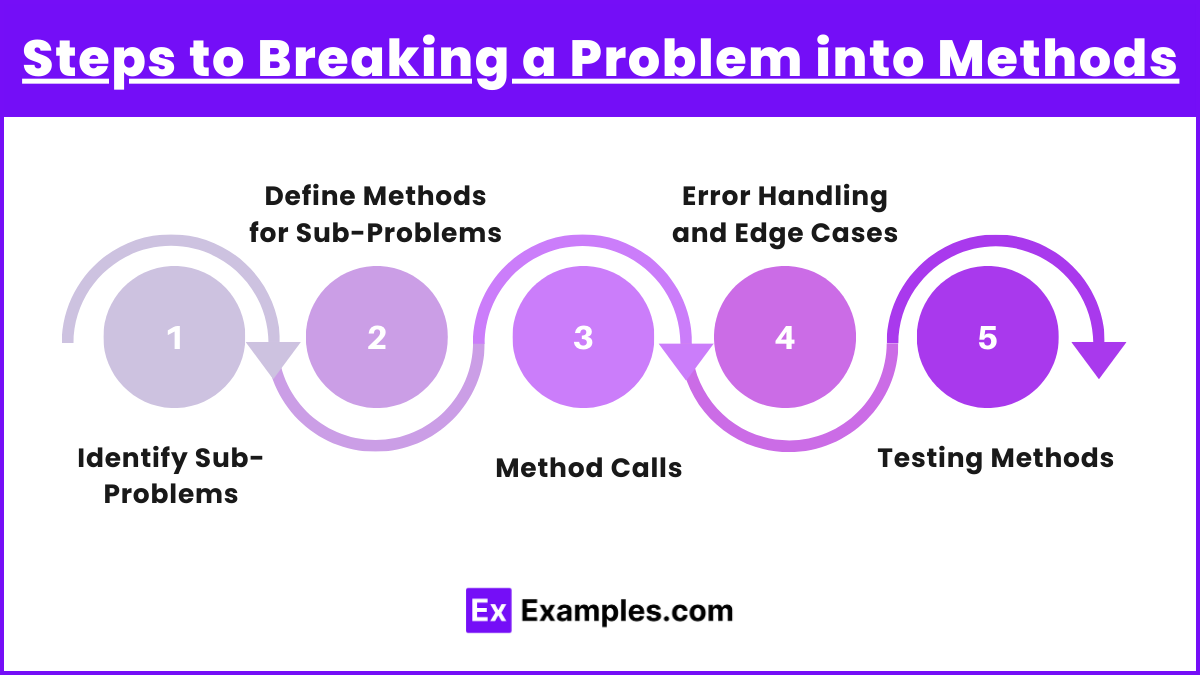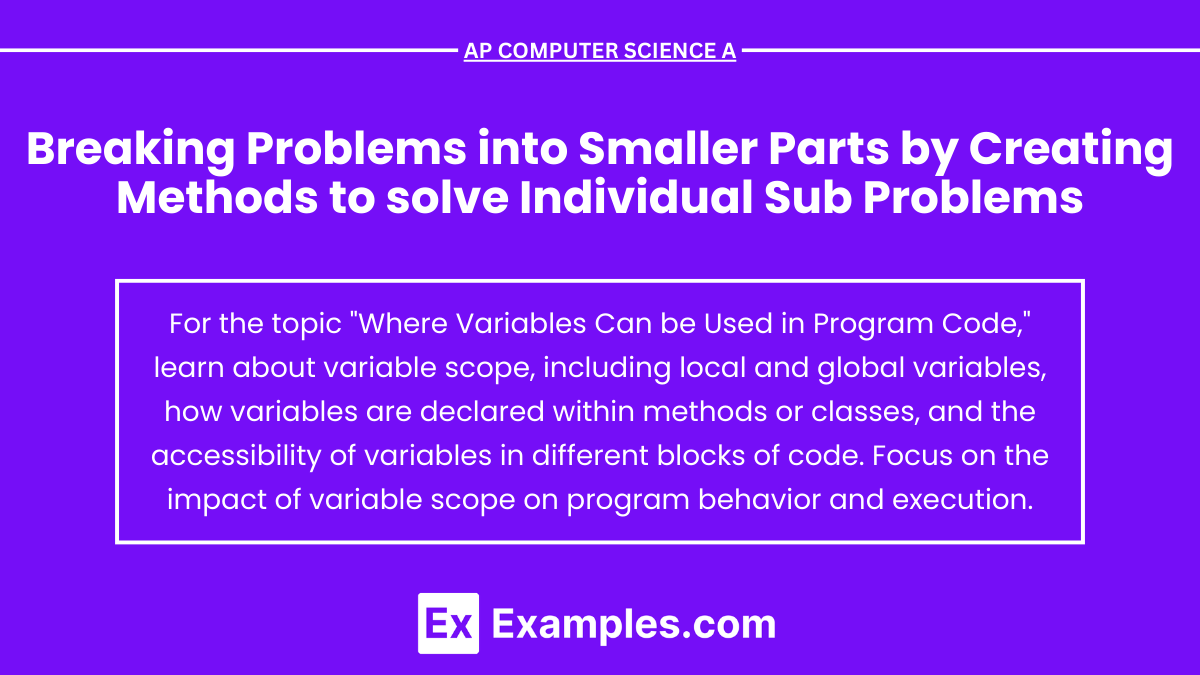Breaking problems into smaller parts by creating methods to solve individual sub-problems is a fundamental approach in AP Computer Science A. This technique, known as decomposition, simplifies complex problems by dividing them into manageable tasks, each handled by a specific method. Methods encapsulate functionality, making code modular, reusable, and easier to debug. By breaking down a large problem into smaller, independent sub-problems, students can create more organized and maintainable programs, demonstrating strong problem-solving skills that are crucial for success in AP Computer Science A.
Free AP Computer Science A Practice Test
Learning Objectives
For the topic "Breaking Problems into Smaller Parts by Creating Methods to Solve Individual Sub-Problems" in AP Computer Science A, you should focus on learning how to decompose complex problems into smaller, manageable tasks, each handled by its own method. Understand how to design methods that perform specific actions, ensure effective parameter passing, and integrate methods to solve the overall problem. Practice testing and debugging individual methods independently and master the benefits of modularity, reusability, and maintainability in code to enhance problem-solving efficiency and clarity.
Breaking Problems into Smaller Parts

In AP Computer Science A, solving complex problems efficiently often involves breaking them into smaller, manageable sub-problems. This approach, known as decomposition, is key to writing modular and organized code. The process entails creating methods to solve individual sub-problems, each handling a specific part of the overall task. This modularization has several benefits:
Benefits of Breaking Problems into Smaller Parts
Code Readability: Breaking a problem into smaller methods makes the code easier to read and understand. Each method has a clear purpose and can be documented individually.
Reusability: Methods can often be reused across different parts of a program. Once a method is written to solve a specific sub-task, it can be called whenever needed, reducing code redundancy.
Maintainability: Modular code is easier to debug and maintain. If an issue arises, you can narrow it down to a specific method rather than combing through the entire program.
Abstraction: Creating methods allows you to hide the complexity of a particular operation behind a simple method call. This abstraction simplifies how the rest of the program interacts with the sub-problems.
Steps to Breaking a Problem into Methods

Identify Sub-Problems: Start by analyzing the larger problem and identifying distinct sub-tasks that can be solved independently. These sub-tasks should align with logical portions of the problem.
Define Methods for Sub-Problems:
Method Signature: Determine the input parameters and return type needed for each method.
Method Body: Write the code that solves the specific sub-problem within the method.
Ensure that each method has a single responsibility, keeping it focused and simple.
Method Calls: Once the individual methods are written, you can call them from the main program or another method to solve the overall problem step-by-step. Ensure proper sequencing and passing of values between methods.
Error Handling and Edge Cases : When designing methods, it's essential to anticipate potential issues or edge cases and handle them appropriately.
Include Error Checking: Incorporate checks to ensure the input is valid before processing it. Example: A withdraw(double amount) method should check if the amount is greater than zero and less than or equal to the current balance.
Handle Exceptional Conditions: Use mechanisms like try-catch blocks to handle exceptions (e.g., invalid input or division by zero). Example: In a method that processes user input, catch any NumberFormatException that might arise if the user inputs a non-numeric value where a number is expected.
Testing Methods : Once the methods are implemented, it is crucial to test them individually before integrating them into the full program. Unit testing is a valuable practice to ensure each method behaves as expected.
Unit Testing: Create test cases for each method to verify that it produces the correct output for a variety of inputs. Example: A method that calculates the area of a circle should be tested with different radii, including edge cases like zero and negative values.
Integration Testing: Once individual methods work correctly, test how they function together when called sequentially or in different orders in the main program. Example: Test that withdrawing money correctly updates the balance, and then call checkBalance() to ensure the balance reflects the changes.
Examples
Example 1: Sorting a List of Numbers
To sort a list of numbers, you can break the problem into smaller parts. You might have a method to divide the list into two parts (divide), a method to recursively sort each part (conquer), and a method to merge the two sorted parts back together (combine). This breakdown aligns with the merge sort algorithm, where each smaller method handles a sub-task of the overall problem.
Example 2: Calculating a Student’s GPA
To calculate a student's GPA, the problem can be divided into individual methods. One method can gather the list of courses and corresponding grades, another method can convert the grades into grade points, and a third method can calculate the weighted average. Finally, a method can print the GPA, combining the results of the previous methods.
Example 3: Simulating a Voting System
In a voting system, different functionalities like recording votes, calculating the results, and displaying the winner can be divided into methods. One method might register a vote, another method might tally the votes, and a final method might announce the result. This modular approach helps in making each part of the voting system manageable and reusable.
Example 4: Generating a Report
When creating a report from a dataset, you can break the problem into methods that handle data retrieval, data processing, formatting, and report generation. Each method focuses on a distinct task—getting data from a database, processing it into the desired format, adding headers and footers, and finally printing or saving the report. This separation simplifies maintenance and testing.
Example 5: Building a Calculator
A calculator program can be broken into smaller methods for each operation (e.g., addition, subtraction, multiplication, division). The main method could accept user input and call the appropriate operation methods based on the user's selection. This design allows you to easily add new operations or modify existing ones by working on specific methods rather than the entire program.
Multiple Choice Questions
Question 1
Which of the following is not a benefit of breaking a problem into smaller parts and solving them using methods in Java?
A) Reusability of code
B) Improved maintainability
C) Code becomes more complex and harder to understand
D) Easier testing and debugging
Answer: C) Code becomes more complex and harder to understand
Explanation: Breaking a problem into smaller parts by using methods simplifies code and makes it easier to manage, understand, and maintain. Each method handles a specific task, improving modularity and readability. The incorrect option is C because creating methods makes the code less complex and easier to understand, not harder.
Question 2
When solving a problem by breaking it down into methods, which of the following should be considered first?
A) Writing the main method
B) Identifying the major tasks or sub-problems
C) Deciding the data types of variables
D) Testing the individual methods
Answer: B) Identifying the major tasks or sub-problems
Explanation: Before writing any code, the first step in problem decomposition is to identify the major tasks or sub-problems. This ensures that each method addresses a specific aspect of the overall problem. Once the sub-problems are identified, methods can be written to handle each one. Options A, C, and D are secondary steps that come after problem decomposition.
Question 3
Consider a method that calculates the total price of items in a shopping cart. This method is an example of:
A) Problem decomposition
B) Top-down design
C) Reusability of code
D) All of the above
Answer: D) All of the above
Explanation: The method that calculates the total price of items in a shopping cart demonstrates all of the following concepts:
Problem decomposition: The method handles one sub-problem (calculating total price).
Top-down design: It could be part of a larger program where this task is decomposed from the larger task of managing a shopping cart.
Reusability of code: The method can be reused whenever a total price calculation is needed. Thus, the correct answer is D.


